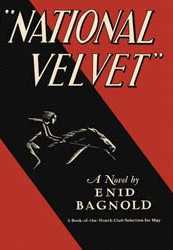National Velvet
| National Velvet | |
|---|---|
 1st edition | |
| Author | Enid Bagnold |
| Illustrator | Paul Brown (1949 edition) |
| Country | Great Britain |
| Language | English |
| Subject | Horses |
| Genre | Novel |
| Publisher | William Morrow & Co. |
Publication date | 1935 |
| Pages | 306 |
National Velvet is a novel by Enid Bagnold (1889–1981), first published in 1935.
Plot summary
"National Velvet" is the story of a 14-year-old girl named Velvet Brown, who rides her horse to victory in the Grand National steeplechase. The horse which Velvet trains and rides in the Grand National is named The Piebald, because it is piebald colour.
The novel focuses on the ability of ordinary persons, particularly women, to accomplish great things. Velvet is a teenager in the late 1920s, living in a small English coastal village in Sussex, dreaming of one day owning many horses. She is a high-strung, nervous child with a delicate stomach. Her mother is a wise, taciturn woman who was once famous for swimming the English Channel; her father is a butcher.
Her best friend is her father's assistant, Mi (Michael) Taylor, whose father – as Mrs. Brown's swimming coach – helped her cross the channel. Mi formerly worked in stables and is familiar with the horse racing world. One day they both watch The Pie jump over a five-foot-high cobbled fence to get out of a field. Mi says, in passing, that "a horse like that'd win the National".[1] Velvet becomes obsessed with winning the horse in an upcoming raffle and riding him to greatness.
In addition to inheriting several horses from one of her father's customers, a man who left them to her in his will, Velvet actually does win her dream horse. After riding him in a local gymkhana, she and Mi become serious about entering the Grand National steeplechase at Aintree racecourse and train the Piebald accordingly.
Mi uses his connections to the horse training/racing world and obtains a fake clearance document for Velvet in the name of James Tasky, a Russian jockey. Velvet wins, but slides off after the winning-post due to exhaustion, and her sex is discovered in the first-aid station.
The racing world is both dismayed and fascinated by a young girl's winning its toughest race. Velvet and The Pie become instant celebrities, with Velvet and her family nearly drowning in notoriety (echoing her mother's unsought fame after swimming the English Channel), complete with merchandising. Velvet strongly objects to the publicity, saying The Piebald is a creature of glory who shouldn't be cheapened in tabloid trash and newsreels. She insists that she did not win the race, the horse did, and she simply wanted to see him go down in history. The National Hunt Committee finds no evidence of fraud, exonerates all involved, and Velvet and her family return to their ordinary lives; or rather, Velvet goes on "to her next adventures", for clearly she is a person to whom great things happen.
Film adaptation
The novel was made into a more or less faithful, highly successful film version in 1944, starring twelve-year-old Elizabeth Taylor and Mickey Rooney, with Donald Crisp, Anne Revere and a young Angela Lansbury. In 2008 the film was voted the ninth best American film in the sports genre.[2][3]
Television adaptation
From 1960 to 1962, there was a half-hour B&W American television series, with Lori Martin, Ann Doran and James McCallion. In this version her horse was named King. This aired on NBC for 52 episodes.
Film sequel
A 1978 film sequel, International Velvet, was made starring Tatum O'Neal as Sarah Brown, a young orphaned American teenager living in England with her aunt Velvet Brown (Nanette Newman) after Sarah's parents die in a car accident. Sarah and Velvet purchase the descendant of The Pie after Sarah earns the money by working for Velvet's boyfriend John. They name him Arizona Pie after Sarah's home state. Working with Arizona Pie, Sarah is selected to represent Britain in the equine Three-Day Olympic Event. While working with the horse with trainer Capt Johnson (Anthony Hopkins), she falls for an American competitor, Scott Saunders (Jeffrey Byron). Though distracted by him, she wins the event. Later, after getting engaged to Scott, Sarah returns to England and presents the medal to her aunt Velvet as a keepsake and introduces her and John to Scott.
References
- ↑ Enid Bagnold, "National Velvet", William Morrow & Co. Inc., 1949, p. 67.
- ↑ American Film Institute (2008-06-17). "AFI Crowns Top 10 Films in 10 Classic Genres". ComingSoon.net. Retrieved 2008-06-18.
- ↑ "Top 10 Sports". American Film Institute. Retrieved 2008-06-18.